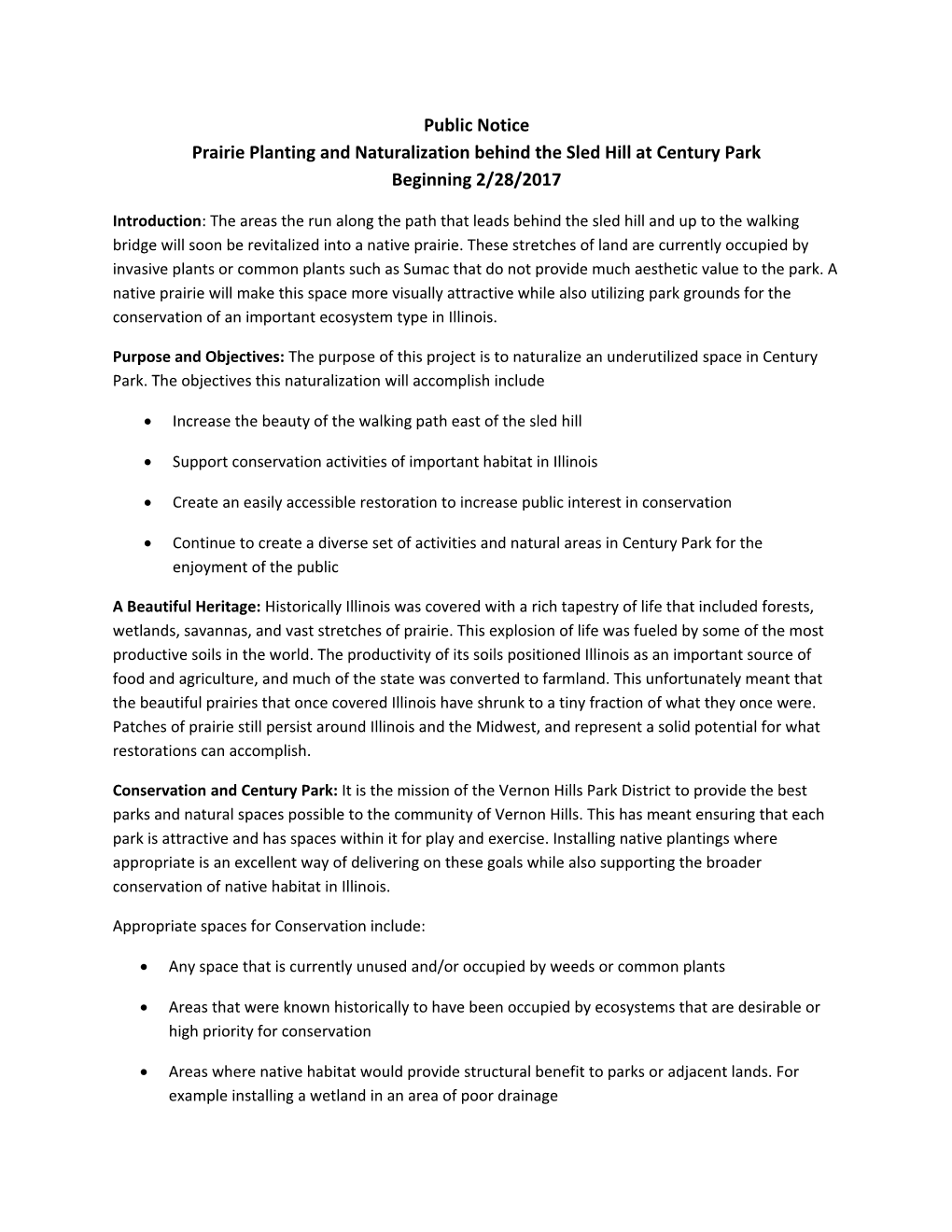Public Notice
Prairie Planting and Naturalization behind the Sled Hill at Century Park
Beginning 2/28/2017
Introduction: The areas the run along the path that leads behind the sled hill and up to the walking bridge will soon be revitalized into a native prairie. These stretches of land are currently occupied by invasive plants or common plants such as Sumac that do not provide much aesthetic value to the park. A native prairie will make this space more visually attractive while also utilizing park grounds for the conservation of an important ecosystem type in Illinois.
Purpose and Objectives: The purpose of this project is to naturalize an underutilized space in Century Park. The objectives this naturalization will accomplish include
- Increase the beauty of the walking path east of the sled hill
- Support conservation activities of important habitat in Illinois
- Create an easily accessible restoration to increase public interest in conservation
- Continue to create a diverse set of activities and natural areas in Century Park for the enjoyment of the public
A Beautiful Heritage: Historically Illinois was covered with a rich tapestry of life that included forests, wetlands, savannas,and vast stretches of prairie. This explosion of life was fueled by some of the most productive soils in the world. The productivity of its soils positioned Illinois as an important source of food and agriculture, and much of the state was converted to farmland. This unfortunately meant that the beautiful prairies that once covered Illinois have shrunk to a tiny fraction of what they once were. Patches of prairie still persist around Illinois and the Midwest, and represent a solidpotential for what restorations can accomplish.
Conservation and Century Park: It is the mission of the Vernon Hills Park District to provide the best parks and natural spacespossible to the community of Vernon Hills. This has meant ensuring that each park is attractive and has spaces within it for play and exercise. Installing native plantings where appropriate is an excellent way of delivering on these goals while also supporting the broader conservation of native habitat in Illinois.
Appropriate spaces for Conservation include:
- Any space that is currently unused and/or occupied by weeds or common plants
- Areas that were known historically to have been occupied by ecosystems that are desirable or high priority for conservation
- Areas where native habitat would provide structural benefit to parks or adjacent lands. For example installing a wetland in an area of poor drainage
Prairie Ecosystems and Illinois: Prairie is formed from plants and grasses in areas without significant tree cover. Grassland ecosystems such as prairie and savanna require significant disturbances to maintain their health and prevent encroachment by woody plants. Without disturbance such as fire or grazing to prevent their growth, trees and shrubs will out-compete prairie plants. As they reach maturity the canopies of these trees shade out the sun dependent prairie species.
Prairies provide many important ecosystem functions. Many species of wildlife rely on prairie ecosystems for food and shelter.
Prairie Wildlife
Different species of birds nest almost exclusively in open grasslands, and have seen serious population declines with the disappearance of prairie from the landscape of Illinois. (Reference) Restoring this habitat has successfully increased reproductive success for these vulnerable bird species and may help restore their populations around the area. (Reference)
Other Wildlife historically present in prairie includes rodents, prairie dogs, and birds of prey. Large grazers such as bison were also present. The restoration in Century Park will not be large enough to support mammals larger than rodents, but may be visited by birds of prey looking to snack on those rodents.
Timeline
Winter of 2016 / 2017 - a forestry mower was rented to chew down the existing invasive Buckthorn and Honeysuckle, and undesirable Boxelder trees, Mulberry trees and re-sprouting Ash trees.
Late summer 2017 – Re-sprouting invasives and trees were mowed back down using our tractor mounted Brush Hog. The chewed up material was made into piles and burned off during the early winter.
Early 2018 – The area was overseeded with Perennial Rye grass
Summer of 2018 – The area will be temporarily converted to turf grass and unwanted returning broad leaf plants will be treated with selective herbicide.
The series of events that follow will depend on how long it takes to eradicate the unwanted broadleaf plants that were previously established. Pending the level of control of unwanted broadleaf plants, sections of turf will be killed off and overseeded with native prairie plants. The final goal is to establish native prairie plants and a mix of Oak Trees planted across the island and along side the sled hill.
